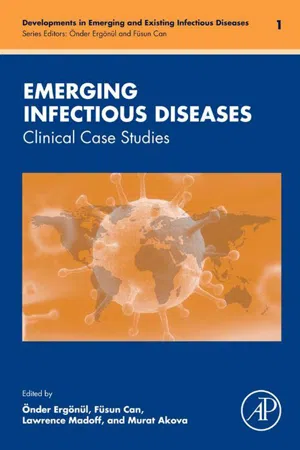Ebola Virus
Ebola virus is a highly contagious and often fatal virus that causes severe hemorrhagic fever in humans and nonhuman primates. It is transmitted through direct contact with the blood, body fluids, and tissues of infected individuals or animals. The virus can lead to symptoms such as fever, muscle pain, vomiting, and bleeding, and has caused several outbreaks in Africa.
8 Key excerpts on "Ebola Virus"
- eBook - ePub
- Michael G. Cordingley(Author)
- 2017(Publication Date)
- Harvard University Press(Publisher)
...· 12 · EBOLAVIRUS T HE EBOV M AKONA OUTBREAK, tragic though it was, provided a unique opportunity for scientists to accumulate empirical observations of Ebolavirus biology and evolution. Hard data could now replace mere speculation. We will begin by laying the groundwork and discussing the family Filoviridae that is made up of three genera: Ebolavirus, Marburgvirus, and Cuevavirus. Among these genera and among the five recognized Ebolavirus species, there is a wide spectrum of pathogenicity for humans and nonhuman primates. The storied Reston ebolavirus achieved repute after it caused a deadly outbreak of Ebola disease in monkeys housed in a U.S. animal facility. The fear of a deadly hemorrhagic fever virus threatening to emerge in the American heartland was tangible but ill-founded: the virus was not pathogenic in humans. The outbreaks that have come to our attention in central Africa are all associated with severe, often fatal disease in humans and in primates. Human outbreaks have been linked to wildlife die-offs (Leroy, Rouquet, et al. 2004). The outbreaks are so feared because of the ruthless efficiency with which the virus replicates and spreads systemically, apparently unchecked, resulting in renegade inflammatory responses causing the filovirus-typical disease symptoms: extremely high fevers, vascular leakage, and bleeding disorders. It is ironic that the rapidity with which the infection takes down its victims and the horrific symptomology of the disease are the very factors that have restricted its capacity to establish extended chains of transmission in man. It is simply too pathogenic to cause a pandemic. Direct physical contact with body fluids of the infected victim is required for transmission, so the combination of effective quarantine measures, contact tracing, and rigorous deployment of protective gear to health care workers has routinely brought a halt to outbreaks...
- eBook - ePub
Viral Polymerases
Structures, Functions and Roles as Antiviral Drug Targets
- Satya Prakash Gupta(Author)
- 2018(Publication Date)
- Academic Press(Publisher)
...End hosts are humans (and other primates in the case of RESTV), due to “bush-meat” consumption and the increasing interactions with wildlife (Feldmann, 2014 ; WHO, 2016b). In humans, Ebolavirus seems to enter through mucosal surfaces, breaks, and abrasions in the skin, or by other parenteral introduction. Most human infection outbreaks seem to occur by direct contact with infected patients or cadavers. Ebola Virus can survive for a few hours in a dried state and for a few days within body fluids outside the organism. Moreover, after a person recovers from the acute phase of the disease, it survives for months in organs like the eyes and testes (CDC, 2018). The illness is characterized with a high temperature of about 39°C, hematemesis, diarrhea with blood, retrosternal abdominal pain, prostration with heavy articulations, and rapid occurrence of death after a mean of 3 days. The incubation period is between 2 and 21 days and death, if it occurs, follows typically 6–16 days from first symptoms (WHO, 2016b). Transmission is not airborne and symptoms occur early, however we must consider the pandemic possibility if it were to occur in a big city with good travel connections, due to the high mortality rate and transmission speed. The greatest fear is associated to bioterrorism: Ebola Viruses are included in biohazard agent level 4 and bioterrorism agent category A (Hoenen et al., 2006). 7.2 Structure and Genome Ebola Virus is one of the three Genre of the Family Filoviridae (Order Mononegavirales). Marburgvirus and Cuevavirus are the others two Genre. The prefix “Filo” suggests its filamentous shape (Kiley et al., 1982). Each Ebola Virus carries a helical single-stranded negative-sense RNA genome of about 19,000 nucleotides. It shows a tubular/cylindrical shape, which contains viral envelope, matrix, and nucleocapsid components. Generally, it is about 920 nm long with a diameter of 80 nm (Klenk and Feldmann, 2004)...
- eBook - ePub
Emerging Infectious Diseases
Clinical Case Studies
- Onder Ergonul, Fusun Can, Murat Akova, Lawrence Madoff(Authors)
- 2014(Publication Date)
- Academic Press(Publisher)
...Chapter 9 Ebola Virus Disease Pierre Formenty, Emerging and Epidemic Zoonotic Diseases Team (CED/EZD), World Health Organization Five species of ebolavirus constitute the genus Ebolavirus, one member of the Filoviridae family. The Bundibugyo, Zaire, and Sudan ebolavirus species cause severe Ebola Virus disease (EVD) outbreaks in humans whereas the Reston and Taï Forest species do not. EVD is a febrile hemorrhagic illness, which causes death in 25–90% of all clinically ill cases. EVD outbreaks occur primarily in remote villages in Central and West Africa, near tropical rainforests. The virus is transmitted to people from wild animals and spreads in the human population through human-to-human transmission. Fruit bats of the Pteropodidae family are considered to be the natural host of the Ebola Virus. The laboratory diagnostic remains essential to confirm EVD cases. There is no treatment or vaccine available for either people or animals. Raising awareness of the risk factors of Ebola infection and the protective measures individuals can take is the only way to reduce human infection and death. Keywords Ebolavirus; Bundibugyo virus; Ebola Virus; Sudan virus; Reston virus; Taï Forest virus; Africa; Asia; Ebola Virus disease (EVD) outbreaks Case Presentation In the Taï National Park, Côte d’Ivoire, the behavior of a community of free-living chimpanzees has been studied since 1979 1. In early November 1994, several decomposed corpses of chimpanzees were found and one chimpanzee that had died less than 12 hours previously was dissected on November 16 by three research workers. There were signs of hemorrhage and non-clotting blood. Eight days later, one of the researchers, a 34-year-old woman, became ill. Clinical Course On November 24 (day 1), around 6 pm, the patient started shivering with fever (Figure 9.1). She took a curative dose of halofantrine for suspected malaria...
- eBook - ePub
Ebola
Clinical Patterns, Public Health Concerns
- Joseph R. Masci, Elizabeth Bass(Authors)
- 2017(Publication Date)
- CRC Press(Publisher)
...PART TWO Science and Medicine of Ebola Virus 6 INTRODUCTION Considering the relative rarity of human Ebola Virus infections prior to the 2014–2016 West African outbreaks, a substantial amount was already known about the virus when the outbreak occurred. Five species had been recognized and characterized. Details were known about the virus’ structure, genetics, replication cycle, and means of infecting cells. This body of knowledge will be essential in the development of vaccines and targeted therapies. What follows is a brief overview of this information, with correlations drawn between steps in the viral life cycle and clinical manifestations of Ebola Virus disease (EVD). PHOTO 6.1 Ebola Virus virion. An Ebola Virus virion, shown in a transmission electron microscopic (TEM) image. (Courtesy of Cynthia Goldsmith, CDC, Atlanta, GA.) PHOTO 6.2 Marburg virus. A Marburg virus virion, shown in a transmission electron microscopic (TEM) image. Similar to Ebola, Marburg is a zoonotic RNA virus of the filovirus family. (Courtesy of F.A. Murphy, CDC, Atlanta, GA.) VIRAL NOMENCLATURE The family Filoviridae comprises two genera: the Ebola and the Marburg viruses. There are five recognized species in the genus Ebola. These are Zaire ebolavirus (ZEBOV): First recognized in 1976 in a teacher in Zaire (now Democratic Republic of Congo) who presented with symptoms suggestive of malaria followed by a diffuse rash as well as nausea, vomiting, and diarrhea, an illness similar to that seen in the 2014–2016 West African outbreak. Sudan ebolavirus (SEBOV): Also first identified in 1976 in Sudan. Reston ebolavirus (REBOV): Recognized in 1989 in an outbreak among macaque monkeys. REBOV has also been identified in affected animals imported from the Philippines...
- eBook - ePub
- Richard L. Hodinka, Stephen A. Young, Benjamin A. Pinksy, Richard L. Hodinka, Stephen A. Young, Benjamin A. Pinksy(Authors)
- 2016(Publication Date)
- ASM Press(Publisher)
...Whereas the GP Marburg virus produces one product, Ebola Virus gives rise to a 60- to 70-kiloDalton soluble protein (sGP) and a full-length protein (GP) (9, 10). The viruses have a distinctive filamentous morphology under the electron microscope. Several features of their molecular organization and structure linked these viruses to members of the Paramyxoviridae and Rhabdoviridae families. The viruses have a central core formed by the RNP complex (RNA molecule bound by the NP and VP30, the VP35 and the L protein), which is covered by a lipid envelope derived from the cell plasma membrane where the three remaining structural proteins reside (GP on the outside and VP24 and VP40 located on the inner side of the membrane). The family Filoviridae contains seven species, which are comprised of five Ebola Virus species and one Marburg virus species, as well as one Cuevavirus species. A recent filovirus phylogenetic assessment by Petersen and Holder showed that Marburg virus appears to contain two distinct sympatric lineages. In contrast, Ebola Viruses appear to show allopatric speciation (11). Nipah Virus Henipaviruses are pleomorphic, enveloped viruses with a negative-strand RNA genome. The genome contains six genes encoding glycoproteins F (fusion) and G (receptor-binding), matrix protein M, nucleoprotein N, RNA-dependent RNA polymerase L, and phosphoprotein P. Glycoproteins F and G are required for cell entry and additionally induce neutralizing antibodies. Serologic assays target the antibody response to these proteins (12). The genome is larger than that of other paramyxoviruses due to the extended open reading frame for the P gene (12). Nipah virus is a member of the Paramyxoviridae family, Henipavirus genus. Two strains of Nipah virus have been described: Malaysian strain and Bangladesh strain...
- eBook - ePub
Viruses
Molecular Biology, Host Interactions, and Applications to Biotechnology
- Paula Tennant, Gustavo Fermin, Jerome E. Foster(Authors)
- 2018(Publication Date)
- Academic Press(Publisher)
...Of these species, only RESTV lacks pathogenicity in humans, though it causes disease in nonhuman primates and has been shown to be asymptomatic in pigs. EBOV has proven to be the most lethal species in humans. To date there has only been one human infection of TAFV: an individual infected while performing an autopsy on an infected chimpanzee from the Taï Forest, Ivory Coast. The individual recovered fully after treatment. Replication Cycle Filoviruses enter cells through the interaction of GP, the sole viral glycoprotein in the envelope, which has two distinct regions—GP1 and GP2. GP1 acts in the manner of a Class I membrane fusion protein and has a r eceptor b inding r egion (RBR). This RBR has a high amino acid identity between MARV and EBOV (~47%) and attaches to a cellular receptor thought to be shared by the two filovirus genera. Virus enters the cell by endocytosis where cysteine proteases cleave the GP1 region of the viral glycoprotein. This allows GP1 to bind to an internal endosomal protein receptor called N iemann- P ick C1 (NPC1). Once this occurs, fusion of the viral membrane with that of the endosome is facilitated by the GP2 region and the viral genome is released into the cytoplasm. Transcription of the viral genome into mRNA is initiated by the binding of viral nucleocapsid protein VP30 and starts at the 3′ end. The viral protein L acts as the RdRp and, in tandem with its cofactor VP35 and the DNA topoisomerase of the host cell, orchestrates replication of the genome. Translation of the viral genome leads to the accumulation of viral proteins, and specifically VP35 and NP initiate the production of antigenomes. These antigenomes are in turn used as template for producing additional viral genomes. Viral proteins then accumulate at the cell membrane, where the viral glycoprotein G spikes become inserted into the host cell membrane...
- eBook - ePub
Ebola Virus Disease
From Origin to Outbreak
- Adnan I. Qureshi(Author)
- 2016(Publication Date)
- Academic Press(Publisher)
...The use of the word “pandemic” gives a face to people’s fears and provides hope that most humanity will unite together to fight against the disease. But where did it all start and were there ever other cases reported outside of Africa in the past? “Ebola Virus,” is a household term, but few recognize it as a filamentous virus that has a negative sense ribonucleic acid genome. The term “virus” originates from a Latin word simply meaning “slimy fluid.” Virions are cylindrical or tubular structure containing a viral envelope, matrix, and nucleocapsid component, and are approximately 80 nm in diameter and 800–1000 nm in length. Over a century, this definition has evolved from the first identified human virus, which caused yellow fever reported in 1901 by the US Army physician Walter Reed. The work followed after pioneering work in Cuba by Carlos Finlay, proving that mosquitoes transmitted the deadly disease. The Chamberland–Pasteur filter had been developed in 1884 in Paris by Charles Chamberland, who worked with Louis Pasteur. But it was Dmitri Ivanowski in St. Petersburg in Russia in 1892 who used porcelain filters to isolate and characterize what we now know to be a virus. The name Ebola is derived from the name of the Ebola River near a town called Yambuku in the Democratic Republic of Congo (previously Zaire) where the first outbreak was identified. 2 There have been five subtypes identified, namely, Ebola-Zaire, Ebola-Sudan, Ebola-Bundibugyo, and Ebola-Taï Forest. The fifth which was called Ebola-Reston never actually infected any humans. 2 Figure 3.1 Geographic locations of Ebola Virus disease (1976–2008). Marburg virus disease emergence (1967–1975) The Ebola Virus has characteristics that are very similar to another virus from filoviridae family of viruses called the Marburg virus. This virus was first described in summer of 1967 when an outbreak of unknown disease occurred in Germany and Yugoslavia...
- eBook - ePub
- Douglas D. Richman, Richard J. Whitley, Frederick G. Hayden, Douglas D. Richman, Richard J. Whitley, Frederick G. Hayden(Authors)
- 2016(Publication Date)
- ASM Press(Publisher)
...Defective humoral responses and extensive intravascular apoptosis are associated with fatal outcome in Ebola Virus-infected patients. Nat Med 5: 423–426. [CrossRef] [PubMed] 25. Basler CF. 2005. Interferon antagonists encoded by emerging RNA viruses, p 197–220. In Palese P (ed), Modulation of Host Gene Expression and Innate Immunity by Viruses. Springer, Dordrecht, The Netherlands. [CrossRef] 26. Baize S, Leroy EM, Georges AJ, Georges-Courbot MC, Capron M, Bedjabaga I, Lansoud-Soukate J, Mavoungou E. 2002. Inflammatory responses in Ebola Virus-infected patients. Clin Exp Immunol 128: 163–168. [CrossRef] [PubMed] 27. Harcourt BH, Sanchez A, Offermann MK. 1998. Ebola Virus inhibits induction of genes by double-stranded RNA in endothelial cells. Virology 252: 179–188. [CrossRef] [PubMed] 28. Zaki SR, Greer PW, Coffield LM, Goldsmith CS, Nolte KB, Foucar K, Feddersen RM, Zumwalt RE, Miller GL, Khan AS, Rollin PE, Ksiazek TG, Nichol ST, Mahy BWJ, Peters CJ. 1995. Hantavirus pulmonary syndrome. Pathogenesis of an emerging infectious disease. Am J Pathol 146: 552–579. [PubMed] 29. Kurane I. 2007. Dengue hemorrhagic fever with special emphasis on immunopathogenesis. Comp Immunol Microbiol Infect Dis 30: 329–340. [CrossRef] [PubMed] 30. Burt FJ, Swanepoel R, Shieh WJ, Smith JF, Leman PA, Greer PW, Coffield LM, Rollin PE, Ksiazek TG, Peters CJ, Zaki SR. 1997. Immunohistochemical and in situ localization of Crimean-Congo hemorrhagic fever (CCHF) virus in human tissues and implications for CCHF pathogenesis. Arch Pathol Lab Med 121: 839–846. [PubMed] 31. Lado M, Walker NF, Baker P, Haroon S, Brown CS, Youkee D, Studd N, Kessete Q, Maini R, Boyles T, Hanciles E, Wurie A, Kamara TB, Johnson O, Leather AJ. 2015...







